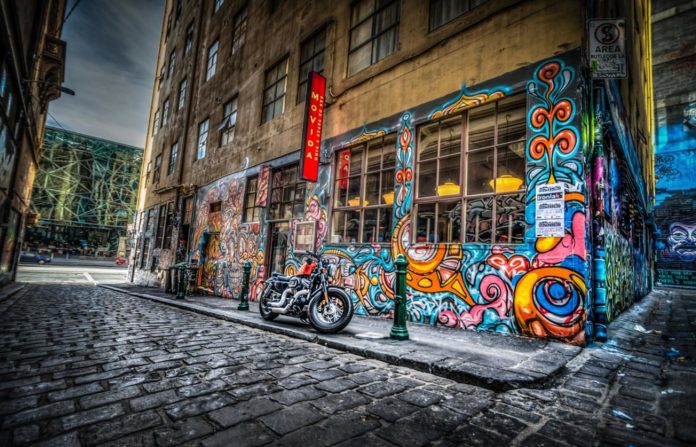The outrage began almost immediately in response to news that 10 men had covered the walls of Melbourne’s famed Hosier Lane. The stunt was filmed by onlookers, but more notably by the masked men themselves, via drone.
One of the artists involved gave an anonymous interview to the Sydney Morning Herald, explaining that the stunt was part of a more expansive project exploring the culture of graffiti. He noted “rebellion, starting conversations [and] making people question things” were all part of what makes the culture unique – aligning his group’s action with the values of street art.
Melbourne Lord Mayor Sally Capp was the first to admit that the action was one that treaded the grey line between art and crime, saying the “balance between street art and graffiti is sometimes difficult to define,” but insisted that the act was “self-centred” and “[created] no value for anyone.” So while it seems that not much can be done in the way of prosecuting the group, since Hosier Lane exists in somewhat of a legal dead-spot for vandalism, public vilification has become the chosen form of punishment.
According to Hosier Lane enthusiasts.. The men have used fire extinguishers at approx 7.30pm Saturday to spray their bad joy. It’s splattered on a mural of Comedian Celeste Barber. @10NewsFirstMelb #springst pic.twitter.com/InadL4k6tc
— Simon Love (@SimoLove) February 9, 2020
I get that urban art is a contest and impermanent but the idiots who did this to a fifth of Hosier Lane last night just destroyed, didn’t create. When they put their videos online best response is to deny the oxygen of ‘fame’ they’re seeking. I won’t be linking. pic.twitter.com/Ld3bdssNNh
— NickdMiller (@NickdMiller) February 9, 2020
Hosier Lane, for years, has served Melbourne as a bustling tourist destination. Swarms of visitors excitedly take photos while they fill the lane, admiring the vibrancy of the work and the many forms it takes.
However, it seems that since Hosier Lane’s rise to Instagram prominence, it’s become somewhat of a safe zone where vandalism was considered non-existent, in the name of allowing artists to express themselves in a way that the city can profit off when the aforementioned scores of tourists flock to visit the ever-changing works.
It has, in a sense, become a place where the messages and challenges to society that exist within traditional street art have been sacrificed in favour of what looks the most appealing and is the most attractive to tourists. It’s not marketed as a place to embrace the messages and commentary that the artists are making with their work, but simply as a place where you can marvel at its aesthetic value.
This act seems to deliberately be begging to the public the question of what gave this particular act the label of vandalism. Is it because of the lack of a tangible image in the dreary, monotone spray of paint? Is it the lack of aesthetic?
Perhaps that’s where the anger is stemming from. What the masked marauders painted across the walls of Hosier Lane wasn’t aesthetically appealing in any way, and no one’s interested in taking a photo of the streaks of colour and drips that it left covering the pieces underneath. It’s not an action that can entirely be justified in the name of respect for street artists, either – there seems to be a lack of regard for the work of their fellow painters in the way the group nonchalantly sprayed over the otherwise remarkable works.
However, maybe this stunt signals that it’s time for us to step back and acknowledge that we have taken some meaning out of the street art. Hosier Lane has been admired at a skin-deep level for too long, and there’s no reason it can’t be time for us to put some edge back into what has become a form of art guided by the attractiveness of its pieces.
So before you jump on the bandwagon of people attacking this group, give some consideration to the bigger picture.
Let us know what you think about the Hosier Lane incident via our socials.

![5 Reasons You Should Travel Alone Airplane [image source: chau nguyen/ http://thedevilhatessweatpants.blogspot.com.au ], crowd ink, crowdink, crowdink.com, crowdink.com.au](https://crowdink.com/wp-content/uploads/2016/08/Chau-airplane-218x150.jpg)




























![5 Reasons You Should Travel Alone Airplane [image source: chau nguyen/ http://thedevilhatessweatpants.blogspot.com.au ], crowd ink, crowdink, crowdink.com, crowdink.com.au](https://crowdink.com/wp-content/uploads/2016/08/Chau-airplane-100x70.jpg)


